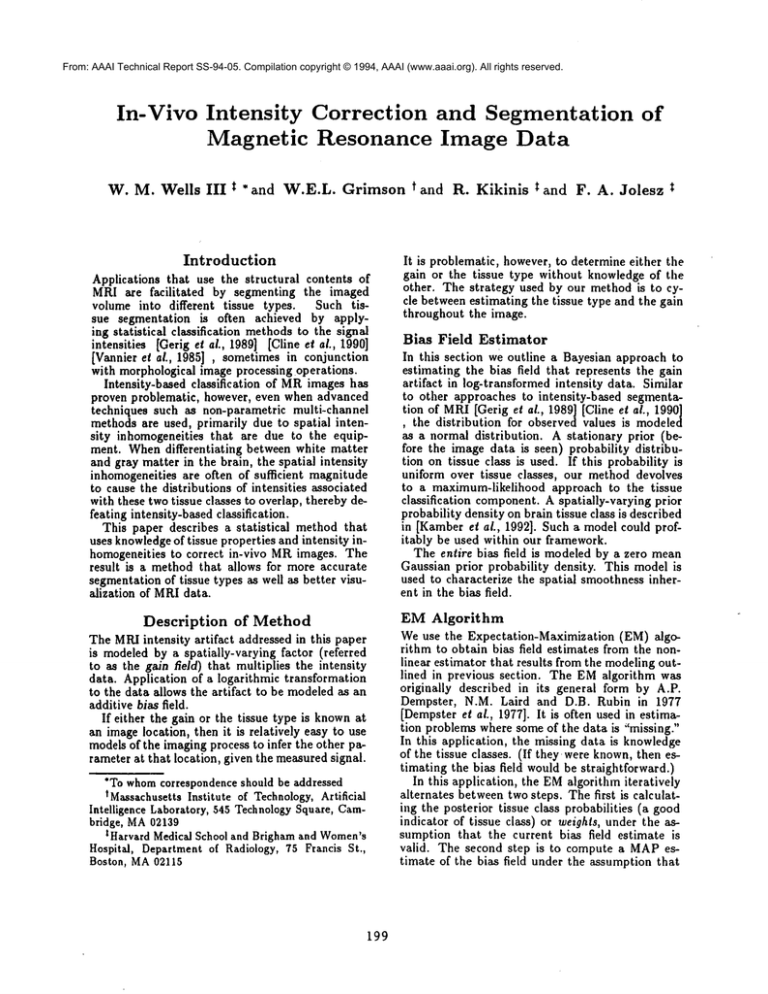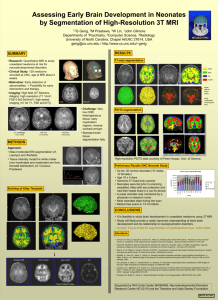
From: AAAI Technical Report SS-94-05. Compilation copyright © 1994, AAAI (www.aaai.org). All rights reserved.
In-Vivo Intensity
Magnetic
W. M. Wells IIIt
Correction
Resonance
* and W.E.L. Grimson t and R. Kikinis
Introduction
Applications that use the structural contents of
MRI are facilitated
by segmenting the imaged
volume into different tissue types. Such tissue segmentation is often achieved by applying statistical classification methodsto the signal
intensities [Gerig el ai., 1989] [Cline et al., 1990]
[Vannier et al., 1985] , sometimes in conjunction
with morphological image processing operations.
Intensity-based classification of MRimages has
proven problematic, however, even when advanced
techniques such as non-parametric multi-channel
methods are used, primarily due to spatial intensity inhomogeneities that are due to the equipment. Whendifferentiating
between white matter
and gray matter in the brain, the spatial intensity
inhomogeneities are often of sufficient magnitude
to cause the distributions of intensities associated
with these two tissue classes to overlap, thereby defeating intensity-based classification.
This paper describes a statistical
method that
uses knowledgeof tissue properties and intensity inhomogeneities to correct in-vivo MRimages. The
result is a method that allows for more accurate
segmentation of tissue types as well as better visualization of MRIdata.
Description
and Segmentation
Image Data
of
t and F. A. Jolesz
t
It is problematic, however, to determine either the
gain or the tissue type without knowledge of the
other. The strategy used by our method is to cycle between estimating the tissue type and the gain
throughout the image.
Bias Field Estimator
In this section we outline a Bayesian approach to
estimating the bias field that represents the gain
artifact in log-transformed intensity data. Similar
to other approaches to intensity-based segmentation of MRI[Gerig et al., 1989] [Cline et al., 1990]
, the distribution for observed values is modeled
as a normal distribution. A stationary prior (before the image data is seen) probability distribution on tissue class is used. If this probability is
uniform over tissue classes, our method devolves
to a maximum-likelihood approach to the tissue
classification component. A spatially-varying prior
probability density on brain tissue class is described
in [Kamber et ai., 1992]. Such a model could profitably be used within our framework.
The entire bias field is modeled by a zero mean
Gaussian prior probability density. This model is
used to characterize the spatial smoothness inherent in the bias field.
EM Algorithm
of Method
The MRIintensity artifact addressed in this paper
is modeled by a spatially-varying factor (referred
to as the gadn t~eld) that multiplies the intensity
data. Application of a logarithmic transformation
to the data allows the artifact to be modeled as an
additive bias field.
If either the gain or the tissue type is knownat
an image location, then it is relatively easy to use
modelsof the imaging process to infer the other parameter at that location, given the measuredsignal.
"To whomcorrespondence should be addressed
!Massachusetts Institute of Technology,Artificial
Intelligence Laboratory, 545 TechnologySquare, Cambridge, MA02139
tHarvard Medical School and Brigham and Women’s
Hospital, Department of Radiology, 75 Francis St.,
Boston, MA02115
199
We use the Expectation-Maximization (EM) algorithm to obtain bias field estimates from the nonlinear estimator that results from the modeling outlined in previous section. The EMalgorithm was
originally described in its general form by A.P.
Dempster, N.M. Laird and D.B. Rubin in 1977
[Dempster et al., 1977]. It is often used in estimation problems where some of the data is "missing."
In this application, the missing data is knowledge
of the tissue classes. (If theywere known,then estimating the bias field would be straightforward.)
In this application, the EMalgorithm iteratively
alternates between two steps. The first is calculating the posterior tissue class probabilities (a good
indicator of tissue class) or weights, under the assumption that the current bias field estimate is
valid. The second step is to compute a MAPestimate of the bias field under the assumption that
the current tissue class probability estimates are
valid.
The iteration maybe started on either step. Initial values for the bias filed will be needed to start
on the first step, while initial values for the weights
will be needed to start with the second step.
It is shown in [Dempster et al., 1977] that in
many cases the EMalgorithm enjoys pleasant convergence properties - namely that iterations will
never worsen the value of the objective function.
Filtering To use the method, we must determine
the linear operator H that represents from the E
step of the algorithm. Ideally, this would be done
by estimating the covariance matrix of the bias
field, but given the size of the matrix, this is impractical.
H may be estimated by several other
means.
In practice, it maybe difficult to obtain the optimal linear filter. H may be instead chosen as a
good engineering approximation of the optimal linear filter. This is the approach we have taken in our
implementation, where the filter was selected empirically. The justification here is the good results
obtained with the method.
Implementation
The results described below were obtained using
an implementation of the method coded in the C
programming language. This single-channel implementation accommodates two tissue classes, and
uses an input region of interest (ROI) to limit
the part of the image to be classified and gaincorrected.
Operating parameters were selected manually.
These were found to be stable with respect to the
type of acquisition. The method is relatively insensitive to parameter settings - for example, errors in the specifications of the class means can be
accommodatedby shifts in the resulting bias field
estimate.
In a typical case, the program was run until the
estimates stabilized, typically in 10 - 20 iterations,
requiring approximately 1 second per iteration on
a Sun Microsystems Sparcstation 2.
Results
All of the MRimages shown in this section were
obtained using a General Electric Sigua 1.5 Tesla
clinical MRimager. An anisotropic diffusion filter
developed by Gerig et al. [Gerig et al., 1992] was
used as a pre-processing step to reduce noise.
Improved
White Matter
Surface
This section describes use of the methodin the segmentation of white matter / gray matter in a coronal gradeint-echo data set. The brain ROI was generated semiautomatically as in [Cline et al., 1990].
Figure 1 shows the sub-cortical white matter surface, as determined by the EMsegmenter. Figure 2
shows the same surface as determined by a conventional intensity-based segmenter. Note in the latter
that the temporal white matter structures are absent, and the generally ragged appearance.
Surface
Coil Brain Example
Here we show the results of using the method on
a sagittal surface coil brain image, as are used in
functional imaging. The five-inch receive-only surface coil was positioned at the back of the head.
Figure 3 shows the intensity image, after having
been windowedby a radiologist for viewing in tile
occipital area. Figure 4 showsthe final gray matter
probability.
The brain ROI was generated manually. Figure 5 shows a corrected intensity image.
Here the gain field estimate has been applied as
a correction, in the brain tissue only. Note the
dramatic improvementin "viewability" - the entire
brain area is nowvisible, although the noise level is
higher in the tissue farthest from the surface coil.
Discussion
Our algorithm iterates two components to convergence: estimation of tissue class probability, and
gain field estimation. Our contribution has been
combine them in an iterative
scheme that yields
a powerful new method for estimating both tissue
class and gain.
The classification
component of our method is
similar
to the
method reported
in
[Gerig el al., 1989] and [Cline et al., 1990]. They
used Maximum-Likelihoodclassification
of voxels
using normal models with two-channel MRintensity signals. They also described a semi-automatic
way of isolating the brain using connectivity.
The bias field estimation component of our
method is somewhat similar to homo-morphic filtering (HMF)approaches that have been reported.
Lufkin et al. [Lufkin et al., 1986] and Axel et al.
[Axel et al., 1987] describe approaches for controlling the dynamic range of surface-coil
MRimages. A low-pass-filtered
version of the image
is taken as an estimate of the gain field, and
used to correct the image. Lim and Pfferbaum
[Lira and Pfferbaum, 1989] use a similar approach
to filtering that handles the boundary in a novel
way, and apply intensity-based segmentation to the
result.
Whenstarted on the "M Step", and run for one
cycle, our method is equivalent to HMFfollowed
by intensity-based segmentation. Wehave discovered, however, that more than one cycle are typically needed to converge to good results - indicating that our method is more powerful than HMF
followed by intensity-based segmentation. The essential difference is that our methodUses knowledge
of the tissue type to help infer the gain. Because of
this it is able to makebetter estimates of the gain.
References
[Axel et ai., 1987] L. Axel, J. Costantini, and .1. Listerud. Intensity Correction in Surface-Coil MRImaging. A JR, 148(4):418-420, 1987.
200
Figure 1: White Matter Surface Determined by EMSegmenter
Figure 2: White Matter Surface Determined by Conventional Intensity-Based
201
Segmentation
Figure5: Corrected
Image
[Cline et al., 1990] H.E. Cline, W.E.Lorensen,R. Kikihis, and F. Jolesz. Three-DimensionalSegmentation
of MRImages of the Head Using Probability and
Connectivity. JCAT, 14(6):1037-1045, 1990.
[Dempster et al., 1977] A.P. Dempster, N.M. Laird,
and D.B. Rubin. MaximumLikelihood from Incomplete Data via the EMAlgorithm. J. Roy. Statist.
Soc., 39:1 - 38, 1977.
[Gerig et ai., 1989] G. Gerig, W. Kuoni, R. Kikinis,
and O. Kfibler. Medical Imaging and ComputerVision: an Integrated Approachfor Diagnosis and Planning. In Proc. 11’th DAGM
Symposium, pages 425443. Springer, 1989.
[Gerig et ai., 1992] G. Gerig, O. K~bler, and F. Jolesz.
Nonlinear Anisotropic Filtering of MRIdata. [EEE
Trans. Med. Imaging, (11):221-232, 1992.
[Kamberet al., 1992] M.
Kamber,
D. Collins, R. Shinghal, G. Francis, and A. Evans.
Model-Based3D Segmentation of Multiple Sclerosis
Lesions in Dual-Echo MRIData. In SPIE Vol. I808,
Visualization in Biomedical Computin9199~, 1992.
[Lira and Pfferbaum, 1989] K.O. Lira and A. Pfferbaum. Segmentation of MRBrain Images into Cerebrospinal Fluid Spaces, White and Gray Matter.
JCAT, 13(4):588-593, 1989.
[Lufkin et al., 1986] R.B.
Lufkin, T. Sharpless, B. Flannigan, and W. Hanafee.
Dynamic-RangeCompression in Surface-Coil MR[.
A JR, 147(379):379-382,1986.
[Vannier et ai., 1985] MVannier, R Butterfield, D Jordan, and WMurphyet al. Multi-Spectral Analysis
of MagneticResonanceImages. Radiology, (154):221
- 224, 1985.
Figure 3: Input Image
Figure 4: Final Gray Matter Probability
202




